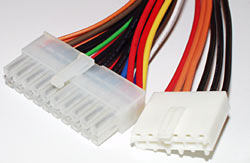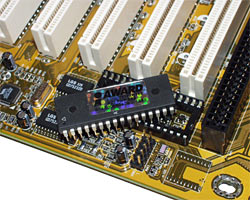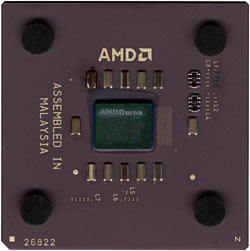
Atomic I/O letters column #4
Originally published in Atomic: Maximum Power Computing Reprinted here 17-Apr-2002.Last modified 16-Jan-2015.
Borked BIOS
I tried to flash my BIOS with a new version, but unfortunately I made some mistake and now I can't boot my PC any more.
My motherboard doesn't support "dual BIOS" or something similar.
The board is still under warranty; I tried to contact the retailer and their response was that they have to send it back to the manufacturer. Oh, no! That's in Taiwan! So it would take at least a couple of weeks until I could use my board again.
Come on! It's just a BIOS. There must be some way to re-flash that thing, right?
I tried to take off the battery on the motherboard and used the clear CMOS jumper, but as I said, it is dead...
"Abit Win"
Answer:
There is indeed a way to fix a BIOS Electrically Erasable Programmable Read
Only Memory (EEPROM) chip whose contents have been corrupted. One way to
do it is with an expensive dedicated EEPROM burner, but you don't need one.
Instead, you can use another, working computer using the same motherboard.
You start the working computer and boot a floppy as if you were about to flash the BIOS as normal (with some recent boards, you can use a Windows BIOS update utility).
Before you flash the BIOS, though, you remove the BIOS chip in the running computer from its socket - which can be rather mechanically tricky to do - and substitute the munged one from your other motherboard. You can do this because, in modern PCs, the BIOS only does anything at the start of the boot process. You can remove and replace it after that.
With the munged BIOS chip in place on the running computer, you can flash it as normal. Then you remove it and put it back on the first board, which should now be fine again.
You can even flash the BIOS for one motherboard on a computer with a different motherboard, if the chips are compatible and the flash utility lets you do it.
If you don't have another computer sitting around, various computer shops can do the job for you. The guys I know at Aus PC Market do it all the time.
Where's the "fast" button?
I used to have an Abit BF6 motherboard, and overclocked my Coppermine P3 700 to 933 easily. Unfortunately I short circuited my motherboard and now have a Gigabyte GA6VX7-4X-1 P3 motherboard.
Can I overclock with this motherboard? I didn't get a manual with it. It has manual jumpers on it. The Abit Soft Menu was great for overclocking.
David McMahon
Answer:
The 6VX-series boards support CPU Front Side Bus (FSB) adjustment, but you
have to use those old-fashioned jumpers to do it. If you need a manual to
tell you the jumper locations and settings, you can download the one to
suit your motherboard from
here. You'll
need to install the free
Acrobat reader
to read the manuals.
Failed overclocker #2
I've got an AMD Duron 750MHz CPU, running on a Gigabyte GA-7ZM mainboard. With help from Atomic issue one, I've unlocked the multiplier on the CPU with a pencil. So far so good. The problem now is: The only way I know to change the voltage of my mainboard is to use the included software EasyTune 3 from Gigabyte. Unfortunately, this program doesn't recognise my CPU, and just terminated itself after a few error messages.
Please help me - is there another way to overclock my Duron?
Tudi
Answer:

Unlocking the multiplier of that Duron won't do you any good, because you can only change the multiplier if your motherboard supports that feature. The GA-7ZM doesn't.
There's also no way to change the CPU voltage on the 7ZM, in the BIOS or with the EasyTune utility.
The only overclocking feature the 7ZM actually offers is a few Front Side Bus (FSB) speed settings between 100 and 133MHz. Increasing the FSB speed will give you a faster CPU speed, but other components may or may not deal well with an elevated FSB.
So many standards to choose from...
I've got a Dell Dimension XPS D233, and I want to upgrade the power supply from the crummy 200 watt standard one to a 300 watt unit.
I've got the new PSU, and I've installed it, and the plugs fit OK, but the computer doesn't work. What's going on?
Answer:
What's going on is, you're using a brand name computer.
I swear, the guys that design these things must go out into the desert and get drunk and fire birdshot at PC standards documents. Anything that ends up with a hole in it, they change for no reason.

Dell power supplies may have the same plugs, but they don't necessarily
have the same wires...
In this case, you've struck one of Dell's dastardly "ATX" power supplies which have standard ATX connectors, physically, but not electrically. The same plugs, but with wires in different places.
Your motherboard uses the normal big ATX power plug, and also the six wire "AUX connector". The AUX connector isn't used for anything in most mass market PCs, but is nonetheless provided on most PSUs.
Unfortunately, Dell decided to delete the 3.3 volt wires from the big connector, and move them to the AUX one.
On pages 20 and 21 of the Acrobat-format service manual for your computer, online in Acrobat format here, you'll find the pinout for the power connectors. The wire colours might be wrong - apparently Dell make machines with blue wires where page 21 says there should be orange ones, for instance - but the voltages should be right.
A normal ATX PSU outputs absolutely everything that the special Dell one does, as far as I know. It's just in different places. If you want to plug a normal PSU into your Dell motherboard, therefore, you'll need to either cut and solder some wires, or go and buy the right unassembled connectors and pins, and a crimping tool.
It would be uncharitable of me to suggest that this sort of apparently reasonless standard-breaking operation is done by name brand computer manufacturers to lock customers into using expensive "genuine" replacement parts, instead of perfectly good dirt cheap generic ones.
So I won't.
BX power!
I currently own a Gigabyte GA-6BXC motherboard with 256Mb RAM, and a PIII 550, all running at a 100MHz. My dilemma is that the 550 just isn't keeping up with the crowd.
After some hunting at swap meets, I got a great deal on a PIII 667 133MHz (still looking for some 133 RAM).
I figure the modest rise from 550 to 667, along with the increase in bus speed to 133, should make some considerable difference. Now my motherboard manual states that I can set the system bus to run at 133, but only gives examples up to 650MHz. Just to confuse me a bit more, the latest BIOS upgrade supports Celeron processors up to 700MHz!
Can I install the 667 and run it at a bus speed of 133MHz on my GA-6BXC?
Michael Gonzalez
Answer:
Yes, you can set the FSB speed of the GA-6BXC to 133MHz, although the manual
doesn't tell you how. You do it with the same DIP switches you use to set
the bus speed normally, and you set DP1, DP2, DP3 and DP4 to OFF, OFF, ON
and OFF, respectively.
Good Intel 440BX chipset motherboards like the 6BXC have a decent chance of working at 133MHz FSB. They support the 1/4 multiplier for PCI bus speed, so bits of the computer that want to run at 33MHz get to keep on doing so.
But if you're using an AGP video card, it's going to get its neck wrung.
No BX board supports any multipliers for AGP bus speed but 1/1 and 2/3. The AGP bus clock speed is 66MHz. So you use the 1/1 multiplier for 66MHz FSB (which is what that 700MHz Celeron uses, by the way), and 2/3 for 100MHz.
At 133MHz FSB, though, 2/3 gives you a 33% overclocked AGP bus, which your graphics card may or may not tolerate.
Nothing will explode if the speed's too high; the computer just won't start, and you'll have to wind the speed down again.
Clockin' a Compaq?
I have been reading your articles concerning the overclocking of the AMD Duron and BIOS tweaking. I own a Compaq Presario 5000 with a AMD Duron 750, but I don't seem to have a BIOS anything at all like anything you have shown. Is it possible to get around the Compaq bios so that I can overclock?
Brad Morris
Answer:
Nope. It's a brand name computer.
Some brand name machines have motherboards with some sort of CPU setting tweaking capability - like the Dell machines that have special Asus boards in them, for instance - but it's not the way to bet. And they never have the tweakability of an off-the-shelf overclockers' motherboard.
Network notwork!
I have 2 computers, one a Pentium 266, and one a Pentium Pro 200. I'm having trouble with the 200.
I've tried to network these machines heaps of times ever since I got the motherboard and processor, but it just doesn't work. The computers only see themselves, and not each other.
Every other person I've asked always says "are they on the same workgroup" or "are the same protocols installed", and both times I answer yes and they can't help me either. I've tried it with both crossover (tested and working) and BNC (tested and working) cables, and numerous different network cards in both computers.
The P-Pro 200's motherboard is an Acer brand and is almost impossible to find any technical support on because it's so damn old.
I know that the 266 networks properly, because I take it to a LAN party every now and then and it works fine.
Both computers run Windows ME and both have the latest drivers for the network cards (both use Realtek RTL8029(AS) PCI cards). Can you help?
Chris Holzworth
Answer:
If you install the TCP/IP protocol on both machines and give them fixed
IP addresses on the same subnet (192.168.1.100 and 192.168.1.101, for instance,
subnet mask 255.255.255.0 for both), then if both network adapters are working
and your cable is good, they'll be able to ping each other. Open a DOS prompt
on either machine and type
ping 192.168.1.100
(or whatever the address of the other machine is). If you get "Reply from..." et cetera, then the link is fine, rejoice!
If you get "Request timed out..." et cetera, my money would be on misconfigured or otherwise dud hardware. I don't know how the motherboard could possibly be the problem, unless it's got a resource conflict that would stop you from setting up the network card properly in the first place.
If the ping works, you can go on to bind whatever you want to TCP/IP, or remove it and add other protocols, or add other protocols and not remove TCP/IP, or do whatever the heck else you want. Windows lets you pile up as many protocols and services as you like.
Turn on File and Printer Sharing (it will by default bind itself to all available network adapters), share at least one folder or drive on each machine, and you should see each machine in the other one's Network Neighborhood. Windows doesn't show machines in Network Neighborhood if they have nothing shared. That's a common beginner problem, by the way.
Nothin' but... dish?
I have a microwave Internet connection. The service provider is Chello, and they work with Austar to provide the service. I have a couple of questions about it.
1) Is there any way to get faster gaming? With my modem I can get a ping of 120 or so, but with microwave I get at least 350. Could this be because the POP is far away?
2) What do you think of microwave Internet? Is ADSL or cable better?
3) And last but not least - can microwave get a higher download rate than 170k/sec?
Luke Evans
Answer:
Asymmetric satellite systems like the Chello/Austar
one, with a broadband microwave download channel but a narrowband modem
upload channel, will always have lousy latency. No good for action games.
This is, as you suggest, because something's far away. That something is the geostationary satellite.
By definition, geostationary orbit is so far up that the orbital period's 24 hours. If a satellite's over the equator and going the right way, a 24 hour orbital period means it doesn't move relative to the surface of the earth. That's why your dish doesn't have to move to stay pointed at the satellite.
For comparison, the Space Shuttle can only get far enough up to have an orbital period of about 90 minutes.
To get that long orbital period, you've got to put a satellite 35,700 kilometres up. It's a little further away again from people who aren't right on the equator.
So when your downstream Internet data travels to the satellite at the speed of light - about 300,000 kilometres per second - and then back from the satellite to you, the round trip takes about 0.24 seconds. That's your absolute raw minimum downstream trip time.
Add in switching delays and the upstream latency - which, for phone line modems, is never too exciting - plus the native latency of the server itself, and 350 milliseconds starts to look like a pretty darn good overall latency.
ADSL and cable are both better than asymmetric satellite if you can get them. If you can't, though, satellite's the next best thing. At least you can download big files at a decent speed. But it's lousy for action games.
In answer to your download speed question - the raw download speed a satellite connection can manage is high, but irrelevant for most purposes. It's throttled by the ISP. According to Usenet posts by other users, Chello seem to cap individual downloads around the 30 kilobyte per second mark. But you can have more than one 30kb/s download running at once.



